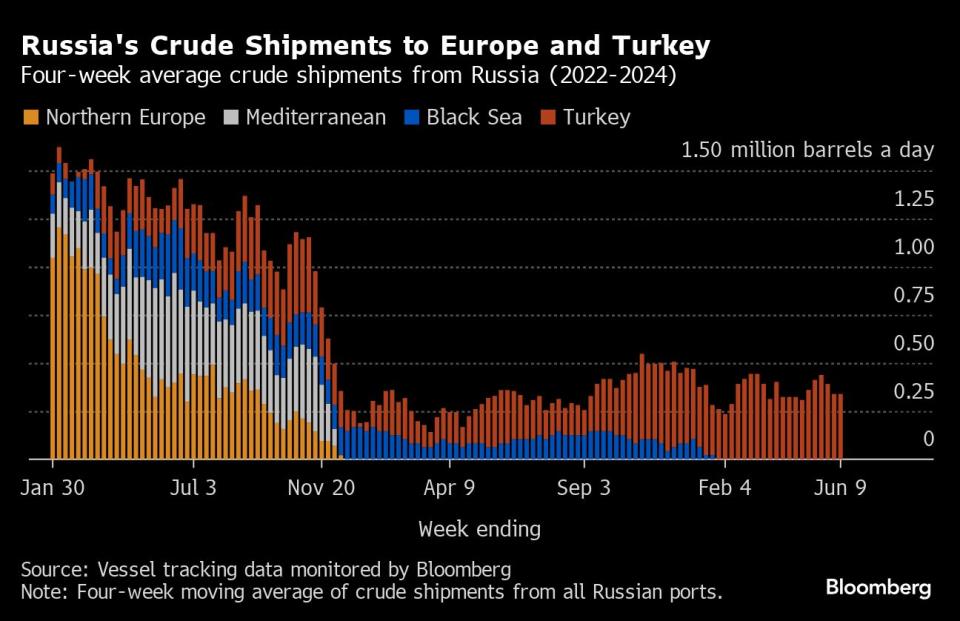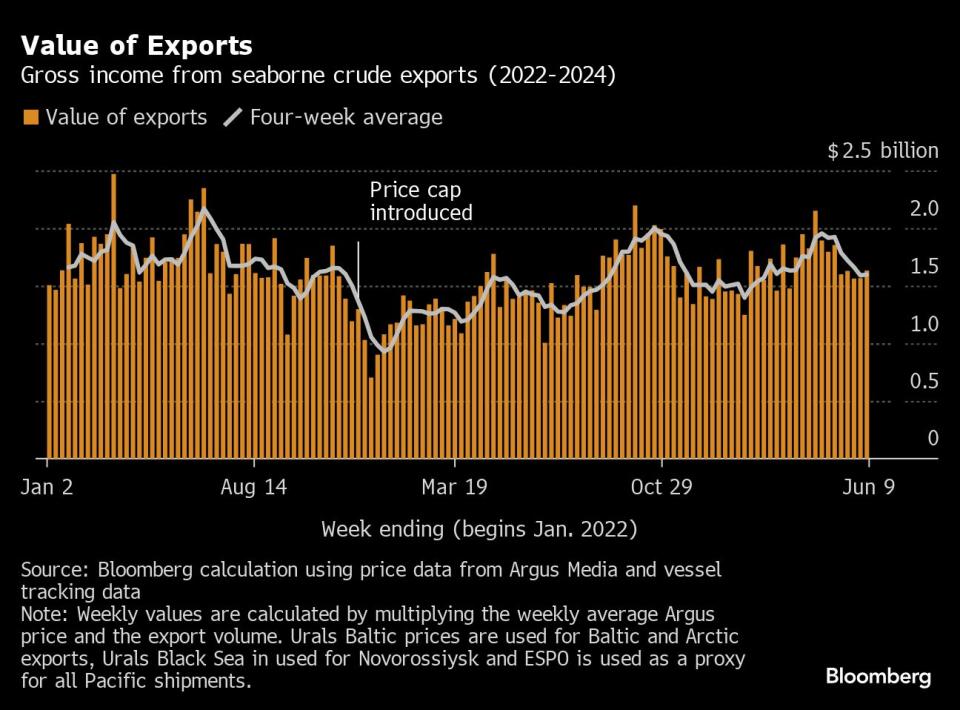Russian Crude Exports Rise to Bring Prolonged Slide to a Halt
(Bloomberg) -- Russia’s four-week average crude exports ticked up in the period to June 9, ending a run of declines.
Most Read from Bloomberg
Dozens of CVS Generic Drug Recalls Expose Link to Tainted Factories
Stocks Rise as Solid Treasury Sale Spurs CPI Bets: Markets Wrap
Exports had fallen in each of the previous four weeks on that measure, producing a cumulative cut of 390,000 barrels a day, or 11%. That was the biggest such reversal since November. The gain of 70,000 barrels a day in the latest number was driven by a jump in weekly shipments to a five-week high.
Overseas crude flows have been tracking below year-earlier levels since late April, with the gap widening to as much as half a million barrels a day before the latest uptick. This may be due to Russia more diligently adhering to an output target that’s part of an effort by the OPEC+ producers to support the market, or it could reflect pressure from international sanctions.
Moscow has pledged to compensate for exceeding its April output target, which it blamed on the “technicalities’’ of achieving significant cuts. But, though it made the deepest reductions in more than a year, Russia still pumped above its promised level last month.Despite the increase in weekly export volumes, a sharp week-on-week drop in oil prices that followed the announcement of a gradual easing of some OPEC+ output restrictions from October limited the increase in the gross value of Russia’s shipments to just 4% in the seven days to June 9.
The Kremlin continues to test US-led restrictions on its oil shipments.
A third sanctioned Russian tanker loaded crude at Novorossiysk in the week to June 9. The Belgorod, until recently named the NS Bravo, took on about 1 million barrels of Urals crude on June 7 and is now in the East Mediterranean, headed for the Suez Canal. The first sanctioned vessel to load, the SCF Primorye, made a hidden transfer of its cargo onto another vessel east of Singapore. The second, the Bratsk, is in the Indian Ocean, heading toward Singapore.
If the cargoes ultimately end up being delivered to oil refineries, it could pave the way for more of the sanctioned tankers owned by state-controlled Sovcomflot PJSC to return to work. The company has now renamed at least 11 of its 21 ships that were listed by the US Treasury Department for breaching a G7-led price cap on Russian oil. All 21 now fly the Russian flag.
Crude Shipments
A total of 32 tankers loaded 24.72 million barrels of Russian crude in the week to June 9, vessel-tracking data and port agent reports show. That was up from 22.53 million barrels the previous week.
Russia’s seaborne crude flows in the week to June 9 rose by 10% to 3.53 million barrels a day. The less volatile four-week average was also up, increasing by about 70,000 barrels a day to 3.34 million, the first increase in five weeks.
A week-on-week increase in shipments from the Black Sea port of Novorossiysk and the Pacific ports of Kozmino and De Kastri was partly offset by fewer departures from the Baltic Sea, Arctic terminals at Murmansk and the Sakhalin Island terminal of Prigorodnoye.
Two shuttle tankers used to haul crude from Russia’s Sakhalin-2 project have failed to move cargoes since April, putting the entire burden of shipments on a single vessel. Unless at least one of them is brought back into service soon, the Sakhalin-2 project will struggle to keep delivering at its normal rate of three to four cargoes a month.
Crude shipments so far this year are running about 10,000 barrels a day above the average for 2023.
Russia terminated its export targets at the end of May, opting instead to restrict production, in line with its partners in the OPEC+ oil producers’ group. The country’s output target is set at 8.978 million barrels a day until the end of September, after which it is set to rise at a rate of 39,000 barrels a day each month until September 2025, as long as market conditions allow.
One cargo of Kazakhstan’s KEBCO was loaded at Ust-Luga during the week.
Flows by Destination
Asia
Most Read from Bloomberg
Observed shipments to Russia’s Asian customers, including those showing no final destination, rebounded to 3 million barrels a day in the four weeks to June 9, from 2.93 million in the four-week period to June 2.
About 1.24 million barrels a day of crude was loaded onto tankers heading to China. The Asian nation’s seaborne imports are boosted by about 800,000 barrels a day of crude delivered from Russia by pipeline, either directly, or via Kazakhstan.
Flows on ships signaling destinations in India averaged about 1.43 million barrels a day, compared with a revised 1.63 million barrels a day in the period to June 2.
Both the Chinese and Indian figures are likely to rise as the discharge ports become clear for vessels that are not currently showing final destinations.
The equivalent of about 285,000 barrels a day was on vessels signaling Port Said or Suez in Egypt. Those voyages typically end at ports in India or China and show up as “Unknown Asia” until a final destination becomes apparent.
The “Other Unknown” volumes, running at about 50,000 barrels a day in the four weeks to June 9, are those on tankers showing no clear destination. Most originate from Russia’s western ports and go on to transit the Suez Canal, but some could end up in Turkey. Others may be moved from one vessel to another, with most such transfers now taking place in the Mediterranean, or more recently off Morocco.
Russia’s oil flows continue to be complicated by the Greek navy carrying out exercises in an area that’s become synonymous with the transfer of the nation’s crude. The activities, which ran until June 3, have now been extended to July 15.
Europe and Turkey
Most Read from Bloomberg
Russia’s seaborne crude exports to European countries have ceased, with flows to Bulgaria halted at the end of last year. Moscow also lost about 500,000 barrels a day of pipeline exports to Poland and Germany at the start of 2023, when those countries stopped purchases.
Turkey is now the only short-haul market for shipments from Russia’s western ports, with flows in the 28 days to June 9 stable at about 340,000 barrels a day.
Export Value
The gross value of Russia’s crude exports rose to a five-week high of $1.63 billion in the seven days to June 9 from about $1.56 billion in the period to June 2, despite a sharp drop in prices. Export values at Baltic and Black Sea ports were down week-on-week by almost $4.50 a barrel, while key Pacific grade ESPO dropped by about $3.70 a barrel. Delivered prices in India also fell, down by about $4.60 a barrel, all according to numbers from Argus Media.
In contrast, four-week average income was little changed, inching higher by about $8 million to $1.6 billion a week, just off its 15-week low. The four-week average peak of $2.17 billion a week was reached in the period to June 19, 2022.
During the first four weeks after the Group of Seven nations’ price cap on Russian crude exports came into effect in early December 2022, the value of seaborne flows fell to a low of $930 million a week, but soon recovered.
NOTES
This story forms part of a weekly series tracking shipments of crude from Russian export terminals and the gross value of those flows. The next update will be on Tuesday, June 18.
All figures exclude cargoes identified as Kazakhstan’s KEBCO grade. Those are shipments made by KazTransoil JSC that transit Russia for export through Novorossiysk and Ust-Luga and are not subject to European Union sanctions or a price cap. The Kazakh barrels are blended with crude of Russian origin to create a uniform export stream. Since Russia’s invasion of Ukraine, Kazakhstan has rebranded its cargoes to distinguish them from those shipped by Russian companies.
Vessel-tracking data are cross-checked against port agent reports as well as flows and ship movements reported by other information providers including Kpler and Vortexa Ltd.
If you are reading this story on the Bloomberg terminal, click here for a link to a PDF file of four-week average flows from Russia to key destinations.
--With assistance from Sherry Su.
Most Read from Bloomberg Businessweek
China’s Economic Powerhouse Is Feeling the Brunt of Its Slowdown
As Banking Moves Online, Branch Design Takes Cues From Starbucks
Food Companies Hope You Won’t Notice Shortages Are Raising Prices
Legacy Airlines Are Thriving With Ultracheap Fares, Crushing Budget Carriers
©2024 Bloomberg L.P.

 Yahoo News
Yahoo News 







